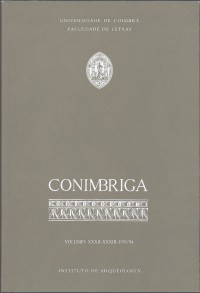Please use this identifier to cite or link to this item:
https://hdl.handle.net/10316.2/45475| DC Field | Value | Language |
|---|---|---|
| dc.contributor.author | Alarcão, Jorge de | - |
| dc.date.accessioned | 2019-02-11T11:26:10Z | |
| dc.date.accessioned | 2020-09-23T01:26:35Z | - |
| dc.date.available | 2019-02-11T11:26:10Z | |
| dc.date.available | 2020-09-23T01:26:35Z | - |
| dc.date.issued | 1994 | - |
| dc.identifier.issn | 0084-9189 | - |
| dc.identifier.issn | 1647-8657 (PDF) | - |
| dc.identifier.uri | https://hdl.handle.net/10316.2/45475 | - |
| dc.description.abstract | Os tempos são múltiplos porque a realidade social tem vários planos: as estruturas económicas e sociais evoluem mais lentamente do que as acções políticas, que se desenrolam num tempo breve. Mas, num outro sentido, os tempos são múltiplos porque as sociedades primitivas têm uma visão predominantemente cíclica do tempo, enquanto as sociedades mais avançadas tem uma visão mais linear, unidireccional. Estuda-se o tempo das coisas, das acções, das normas, dos aparelhos e das paisagens. Coisas e acções vêm do futuro para o passado , enquanto normas, aparelhos e paisagens vêm do passado para o presente. Analisa-se a duração (objectiva ou subjectiva) e devir das coisas; apresenta-se uma breve teoria da acção; discute-se, a propósito das normas, o conceito de habitus de Bourdieu; examinam-se as condições de possibilidade do devir dos aparelhos e analisa-se a percepção do espaço como algo de construível. Distinguem-se depois os conceitos de duração, sucessão e processo e examina-se se o tempo linear é uma intuição transcendental de que o arqueólogo não pode deixar de fazer uso, ou, como pretendem Shanks e Tilley, uma construção capitalista. Por fim, contrastam-se o tempo linear e o tempo cíclico. | por |
| dc.description.abstract | The subject of this paper concerns the perspective of time. Social reality has several levels, each of them with its own rhythm: economic structures move slowly, while historical actions occur in Braudel’s short time-scale. Time too has several levels: primitive people conceive of a cyclical or recurrent time; more developed societies feel that time flows continuously in a single direction. The time spectrum of artifacts, actions, rules, political institutions and landscapes are successively examined. Artifacts and actions take shape in the future, to flow into the present, and disappear into the past. Rules and political institutions on the other hand come to the present from the past. The rise and duration (objective or subjective) of artifacts are considered; a brief theory of action is presented; Bourdieu’s notion of habitus is reconsidered and the conditions under which a change in political institutions may be possible is discussed. The emergence of the perception that the landscape may be altered or reconstructed is dated to the Neolithic. Concepts of duration, succession and process are explored. Linear time is considered as a transcendental intuition and not as a creation of modem capitalism, as proposed by Shanks and Tilley. Finally, the paper contrasts cyclical against linear time. | eng |
| dc.language.iso | por | - |
| dc.publisher | Imprensa da Universidade de Coimbra | - |
| dc.rights | open access | - |
| dc.title | A arqueologia e o tempo | por |
| dc.type | article | - |
| uc.publication.collection | Conimbriga vol. 32/33 | - |
| uc.publication.firstPage | 9 | - |
| uc.publication.lastPage | 56 | - |
| uc.publication.location | Coimbra | - |
| uc.publication.journalTitle | Conimbriga: Revista de Arqueologia | - |
| uc.publication.volume | 32/33 | por |
| dc.identifier.doi | 10.14195/1647-8657_32_33_1 | - |
| uc.publication.orderno | 1 | - |
| uc.publication.area | Artes e Humanidades | - |
| uc.publication.manifest | https://dl.uc.pt/json/iiif/10316.2/45475/235360/manifest?manifest=/json/iiif/10316.2/45475/235360/manifest | - |
| uc.publication.thumbnail | https://dl.uc.pt/retrieve/11510576 | - |
| item.grantfulltext | open | - |
| item.fulltext | With Fulltext | - |
| Appears in Collections: | Conimbriga | |
Files in This Item:
| File | Description | Size | Format | |
|---|---|---|---|---|
| a_arqueologia_e_o_tempo.pdf | 382.09 kB | Adobe PDF |  |
Items in DSpace are protected by copyright, with all rights reserved, unless otherwise indicated.
